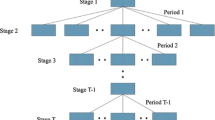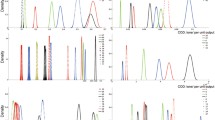Abstract
This paper developed a stochastic linear fractional programming model for industry optimization allocation base on the uncertainty of water resources incorporating chance constrained programming and fractional programming. In this paper, the stochastic linear fractional programming is used in the real word. The development SLFP has the following advantages: (1) The model can compare the two aspects of the targets; (2) The model can reflect the system efficiency intuitively; (3) The model can deal with uncertain issues with probability distribution; (4) The model can give different optimal plans under different risk conditions. The model has a significant value for the industry optimization allocation under uncertainty in local and areas to achieve the maximum economic benefits and the full use of the water resources.


Similar content being viewed by others
References
Chadha SS, Chadha V (2007) Linear fractional programming and duality. CEJOR 15:119–125
Chang CT (2009) A goal programming approach for fuzzy multi objective fractional programming problems. Int J Syst Sci 40(8):867–874
Charnes A, Cooper WW (1959) Chance-constrained programming. Manag Sci 6(1):73–79
Charnes A, Cooper WW, Kirby P (1972) Chance constrained programming: an extension of statistical method. In: Optimizing methods in statistics. Academic, NewYork, pp 391–402
Charnes A, Cooper WW, Rhodes E (1978) Measuring the efficiency of decision making units. Eur J Oper Res 2:429–444
Gomez T, Hernandez M, Leon MA, Caballero R (2006) A forest planning problem solved via a linear fractional goal programming model. For Ecol Manag 227:79–88
Gu JJ, Guo P, Huang GH, Shen N (2012) Optimization of the industrial structure facing sustainable development in resource-based city subjected to water resources under uncertainty. Stoch Env Res Risk A. doi:10.1007/S00477-012-0630-9
Guo P, Huang GH, Li YP (2008) Interval stochastic quadratic programming approach for municipal solid waste management. J Environ Eng Sci 7:568–579
Guo P, Huang GH, Zhu H, Wang XL (2010) A two-stage programming approach for water resources management under randomness and fuzziness. Environ Modell Softw 25(12):1573–1581
Hladik M (2010) Generalized linear fractional programming under interval uncertainty. Eur J Oper Res 205:42–46
Huang GH, Sae-Lim N, Liu L, Chen Z (2001) An interval-parameter fuzzy stochastic programming approach for municipal solid waste management and planning. Environ Model Assess 6:271–283
Khare D, Jat MK, Sunder J (2007) Assessment of water resources allocation options: conjunctive use planning in a link canal command. Resour Conserv Recycl 51(2):487–506
Kondili E, Kaldellis JK, Papapostolou C (2010) A novel systemic approach to water resources optimization in areas with limited water resources. Desalination 250(1):297–301
Lara P, Stancu-Minasian IM (1999) Fractional programming: a tool for the assessment of sustainability. Agric Syst 62:131–141
Li YP, Huang GH, Nie SL, Qin XS (2007) ITCLP: an inexact two-stage chance constrained program for planning waste management systems. Resour Conserv Recycl 49(3):284–307
Liu S, Konstantopoulou F, Gikas P (2011) A mixed integer optimization approach for integrated water resources management. Comput Chem Eng 35(5):858–875
Lv Y, Huang GH, Li YP, Yang ZF, Liu Y, Cheng GH (2010) Planning regional water resources system using an interval fuzzy bi-level programming method. J Environ Inform 16(2):43–56
Mehra A, Chandra S, Bector CR (2007) Acceptable optimality in linear fractional programming with fuzzy coefficients. Fuzzy Optim Decis Making 6:5–16
Miller BL, Wagner HW (1965) Chance constrained programming with joint constraints. Oper Res 13(6):930–945
Min D, Zhenghe X, Limin P (2011) Comprehensive evaluation of water resources carrying capacity of Jining city. Energy Proc 5:1654–1659
Percia C, Mehrez A (1997) Optimal operation of regional system with diverse water quality sources. J Water Resour Plan Manag 123:105
Stancu-Minasian IM (1997) Fractional programming: theory, methods and applications. Kluwer Academic Publishers, Dordrecht
Wei XZ (2009) Study of COD emission trading system about the surface water body. Tianjing University
Yan XP, Ma XF, Huang GH, Wu CZ (2010) An inexact transportation planning model for supporting vehicle emissions management. J Environ Inform 15(2):87–98
Zare Y, Daneshmand A (1995) A linear approximation method for solving a specialclass of the chance constrained programming problem. Eur J Oper Res 80:213–225
Zhu H, Huang GH (2011) SLFP: a stochastic linear fractional programming approach for sustainable waste management. Waste Manage 31:2612–2619
Zhu H, Huang GH, Guo P, Qin XS (2009) A fuzzy robust nonlinear programming model for stream water quality management. Water Resour Manag 23:2913–2940
Acknowledgments
This research was supported by the National Natural Science Foundation of China (No. 41271536, 71071154, 91125017), National High Technology Research and Development Program of China (863 Program) (No. 2011AA100502), Ministry of Water Resources (No. 201001060).
Author information
Authors and Affiliations
Corresponding author
Rights and permissions
About this article
Cite this article
Ren, C.F., Guo, P., Li, M. et al. Optimization of Industrial Structure Considering the Uncertainty of Water Resources. Water Resour Manage 27, 3885–3898 (2013). https://doi.org/10.1007/s11269-013-0385-1
Received:
Accepted:
Published:
Issue Date:
DOI: https://doi.org/10.1007/s11269-013-0385-1




